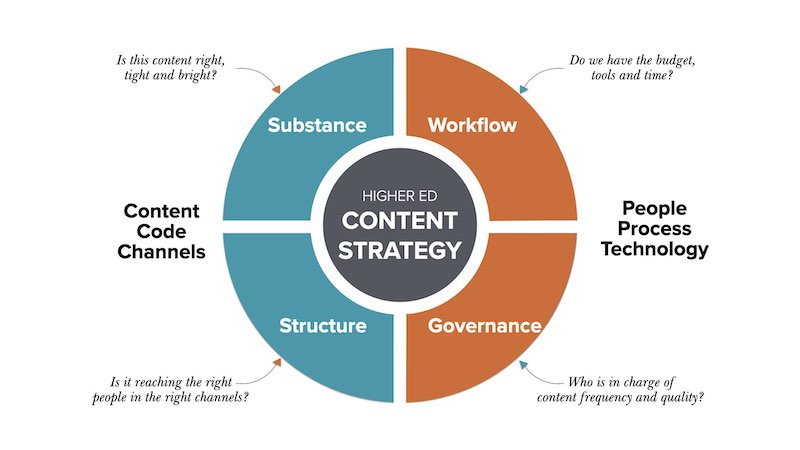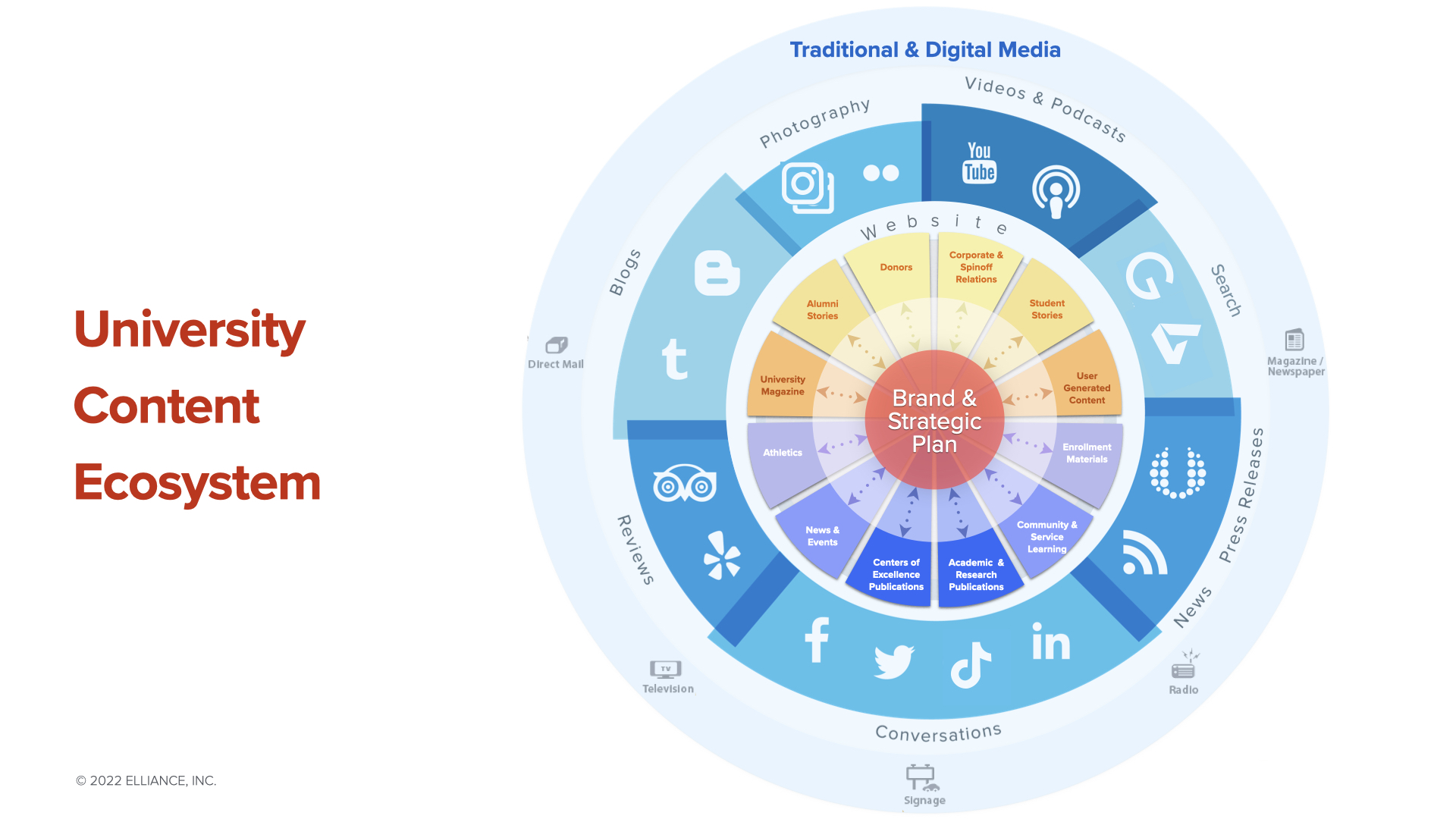| May 30, 2024
Higher Education Content Marketing Strategy for Colleges and Universities: 101 Basics Guide

Great content is the lifeblood of successful brands. Most colleges work tirelessly to produce content, but few understand the steps to make it “productive” in service of realizing broader strategic enrollment, reputation, and advancement goals.
Higher Education Content Marketing Strategy is founded on eight pillars.
- Vision & Goals
- Audiences
- Purpose
- Content Ecosystem
- Types of Content
- Promoting Content
- People, Process & Technology
- Measuring Impact
Let’s explore each pillar in detail.
Vision and Goals
Before you begin articulating a content strategy, review your brand promise, values, pillars and the ideals you want the college to be known for.
Successful colleges connect communication efforts with broader strategic enrollment, reputation, and advancement goals. They expand their community of friends and allies that engage with its offerings and expertise by publishing insightful, practical and valuable content.
Get granular when formulating the goals of your content strategy. For example, the college aspires to grow year-over-year overall enrollment by a x%, increasing enrollment in signature programs by x%, and portfolio of programs by z%.
Audiences
Running a college is often compared to managing a village or a city due to the diverse range of stakeholders it serves. A typical college serves the following stakeholders:
- Students
- Parents
- Faculty
- Staff
- Donors
- Foundations
- Government Funding Agencies
- Corporate and Civic Partners
- Community at Large
- Ranking and Rating Agencies
- Media
Successful content strategy understands and meets the needs, wants and aspirations of all these stakeholders.
Purpose
The primary goal of content marketing is to earn attention and grow brand reputation by providing valuable content – that informs, persuades, engages and delights prospects and other stakeholders. It assures each stakeholder uniquely. For instance, it offers career guidance to enrolled students; it assures prospects that the value of their degree far exceeds its cost; it reassures the donors that their funds are being invested in improvements to community, society and human condition – ultimately creating an institution of consequence.

Content Ecosystem
Website, social media, journals and university flagship magazine form the underpinnings of a college content ecosystem. If a website is a college’s digital soul, journals are its brain, and social media and university magazine are its heart. Successful content strategy renews and rejuvenates these with:
- High-octane student stories that show the students as the heroes on their personal quests
- High-fidelity enrollment communications where a prospect and their family come to know if a college truly understands their deeper needs: the promise of a generative experience, academic rigor, wholesome outcomes and the gut feeling of an emotional fit.
- Academic & research publications published in scholarly and TEDx-like democratized knowledge formats.
- Industry-academia and interdisciplinary centers of excellence publications that transcends traditional academic boundaries.
- News & Events information revealing vibrancy.
- Athletics and intramural sports news that builds school spirit irrespective of whether the school is a division 1, 2 or 3 institution.
- Alumni stories that demonstrate the worth of a college investment by showing the trajectories of generations of alumni, their impact, their passions, their triumphs and the contributions to society.
- Donor stories of their ongoing involvement in shaping the institution and celebrating their personal passions. For corporate and foundation donors, recognizing their generosity and resulting institutional impact on society.
- Corporate and spinoff stories that critically fill the gap created by reduced government funding for R&D.
It’s crucial for the website, social media, journals and university flagship magazine are used as a content engines that treat each story as a keyword-rich Google ranking asset.
Types of Content – Low, Medium, or High Fidelity
Since content freshness is a Google ranking factor, your editorial calendar should prescribe regularly creating fresh content, new stories, consequential news, and event coverage to maintain search visibility and authority. Fresh content can take many forms: copy, stories, photos, infographics, videos, thought leader interviews, articles, white papers, field guides, animations, slideshows, microsites and more. To ensure this content stays within the reach of search engine bots, avoid publishing these in formats like PDF and embeddable flipbooks.

Promoting Content
What’s the the use of creating new content if it’s going to become a lotus flower in the Himalayans, which only a few people can enjoy? Leading content marketing strategists orchestrate content, code, optimization so it surfaces on Google page one. They ensure it can be easily shared by pairing it with social share buttons. They actively promote it to new potential communities of interest.
People, Process and Technology
Because content is the lifeblood of great websites, brands and Google rankings, three things are needed to manage a health content ecosystem: people, processes and frameworks. Key components of a content ecosystem include Keyword Guide, Writing Style Guide, Content Governance Guide and Tools. These must be managed periodically, rationally and systematically. They must cultivate the content habit.
Writers
Your team of content creators, editors and designers should embody both an investigative mindset that discovers and uncovers brand evidence and proofs, and imaginative mindset that infuses brand romance to create persuasive content.
Keyword Guide
Craft a Keyword Lexicon that contains clusters of keywords and phrases spanning your academic programs, brand ideals, and areas of thought leadership, innovation and intellectual capital. Laying claim to the keywords begins with an intentional plan. Categories in the lexicon should include academic program keywords, brand positioning keywords, reputation keywords, decisioning keywords, and location keywords.
Know that prospects use different clusters of keywords at each phase of the decision funnel. e.g. they’ll use reputation keywords during the awareness phase, category keywords during the consideration phase and branded keywords during the preference/purchase phase.
![]()
Editorial Calendar
Editorial Calendar spells out content types and formats, publishing dates, content themes and topics, target audience, primary and secondary keywords, editorial guidelines, reference sources and more.
Writing Style Guide
Writing Style Guide spells out appropriate use of college name, degree names, acronyms and abbreviations, style and tone guidelines, inclusive language, words to use and avoid, spelling and capitalizations, when to deviate from AP style, citations and references, and brand promise, values, pillars, line and statements, etc.
Content Governance Guide
Content Governance Guide recommends what content should be updated by various team members to ensure the website, social media, journals and university magazine remain fresh and current.
Tools
Defines acceptable use of AI writing tools.
Measuring Impact
As management guru Peter Drucker said “What you can’t measure, you can’t manage.” Effective content marketing strategy mandates you measure the ROI of your efforts via dashboards and KPIs. Essential metrics worth measuring include:
- Views and popularity
- Bounce rate or time spent on a content asset
- Number of shares
- Google page one rankings
- Impact on inquiries, enrolls, melt rates and retention rates
- Impact on giving rate and donations
- Number of new partnerships formed
- Improvement in US News rankings
In the next blog post, I will share our agency’s content marketing best practices for colleges, universities and higher education institutions.
If you are seeking an inspired content marketing agency for your organization, consider partnering with us.
